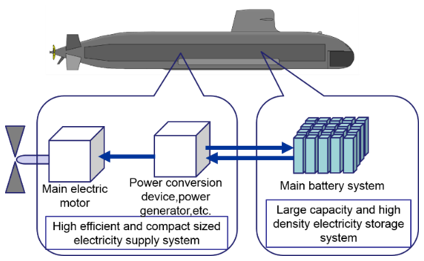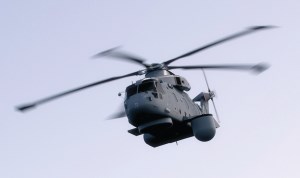Pete thanks wispywood2344 for his May 15, 2021, 1:34:00 PM advice that the Japanese Soryu Mk.II and Taigei-class submarine Lithium-ion Battery (LIB) formula (confidentially termed "SLH") is, in fact, LCO, ie. Lithium Cobalt Oxide (LiCoO2)
Wispy notes LCO is a different substance
from the other LIB formula "NCA" ie. Lithium Nickel Cobalt Aluminum Oxide (LiNiCoAlO2) believed to be intended for Japanese submarines.
Wispy's comment that Japanese submarine's current LIB formula being LCO takes into account:
- the
development period and technology trend of LIBs and
- Japanese language GS Yuasa Technology Co Ltd. (GYT) document which Wispy deems "highly reliable" with link https://ssl.bsk-z.or.jp/kenkyucenter/pdf/gyt20201210.pdf .
That document was written by employees of large battery producing company GS Yuasa and Mitsubishi Heavy Industry (MHI):
Pete has now translated this document:
TITLE: “Realization
of the world's first submarine equipped with a lithium-ion battery system”
DATED: [noting the most
commonly used date format in Japan is "year month day”] “20201210” means December 10, 2020.
BY: Takahiro Ida,
Hidefumi Hasegawa and Kazuyuki Kawamoto all of GS Yuasa Technology Co., Ltd. and by Hiroshi Tonomoto and Ken Nitta of the Defense and Space
Segment, Submarine Engineering Department, Ships and Special Machinery Division
of Mitsubishi Heavy Industries Ltd.
"1. 1. Introduction
GS Yuasa Technology Co., Ltd. (GYT) has been manufacturing
lead-acid batteries for submarines for many years.
Based on this abundant battery building experience we
will mass produce lithium-ion batteries for submarines.
We have completed the development of
lithium-ion batteries [LIBs] for submarines that match the quality and performance
required for submarine use.
Mitsubishi Heavy Industries, Ltd. (MHI)
has made lithium-ion batteries safe and fully functional.
We have developed a [computerized onboard submaine] main storage battery management [and safety] control device
for LIBs on submarine. GS Yuasa and MHI signed a mass production contract for LIBs on submarine with the Japan's MoD Acquisition, Technology and Logistics Agency (ATLA) in 2015.
[ Pete Comment: See "Research on high-efficient electricity storage and supply
system for submarines" on ATLA website here at https://www.mod.go.jp/atla/en/soubi_kansen.html with the ATLA diagram and description below:
[ATLA explains] "Conduct research on electricity storage system with large capacity and high density, electricity supply system with high efficient and compact sized to extend submarines’ underwater endurance without increasing ship size." ]
GS Yuasa Technology Co., Ltd. (GYT) started mass production of LIB batteries in March 2017. This proceeded smoothly. In August 2018 GS Yuasa Technology Co., Ltd. (GYT) delivered them to MHI.
After that, the submarine [Soryu Mk. II] JS Oryu was equipped with lithium-ion
batteries. The main storage battery computerized management device was integrated into Oryu from the
summer of 2019.
After JS Oryu's sea trials, Oryu [with its Lithium-ion Batteries] was handed over to the [Japanese Navy] Maritime
Self-Defense Force in the spring of 2020.
2. 2. Development history
GYT established mass production technology for lithium-ion
batteries around 1993, and lithium to be installed in submarines in 1994.
GYT proposed the development of an ion battery to MHI's Technical Research and Development Institute (TRDI) [see ATLA's precursor TRDI] at that time under MHI.
In 2003, GYT and MHI's TRDI were contracted to develop "new main storage battery for submarines. [likely by Japan's Ministry of Defense (MoD) which likely provided startup, ongoing and on completion funding].
Participated in "Research Trial"
GYT, conducted
research trials, and completed the development of lithium-ion batteries for
submarines.
3. 3. Development overview
3.1 Lithium-ion battery
Lithium-ion batteries [LIBs] generally have the following superior
performance compared to lead-acid batteries, so they are used in submarines.
LIBs should contribute to improvements of
performance, due to.
・ High energy density: Can store more power and discharge
・ Long life: Reduced number of battery replacements
・ High charging efficiency: Shortening charging time
・ Excellent discharge characteristics: Sufficient capacity
can be taken out even with a large current.
・ No hydrogen gas generation: [So no need to take safety
measures against hydrogen gas].
・ No maintenance required: No battery maintenance required
・ No maintenance required: No battery maintenance required
Figure 1 [can be seen on Page 2 of the original document] shows the external view of the new lithium-ion
battery (hereinafter referred to as SLH type) developed by GYT.
The SLH LIB's dimensions are specifically designed to be the same size as the preceding lead-acid batteries.
The lead-acid battery was a single cell, while the SLH type
configuration is an aggregate of 10 cells arranged in 2 rows
and 5 stages and connected in series. Table 1 [also on Page 2 of the original document] shows the main points of the SLH
type.
Table 1 indicates Lithium cobalt oxide, which can achieve high
energy density, is used as the positive electrode material.
In addition, as will be described later, the SLH type is
equipped with a battery monitoring unit that measures the cell voltage and cell
temperature at the top.
[From documentDetails]
Fig. 1 External view of the new main storage battery SLH
type
Table 1 Key points of the new main storage battery SLH type
[Table 1 literally translated is:]
Table 1 Key points of the new main storage battery SLH type
Item New main storage battery SLH type
Structure sealed type
Electrolyte Organic electrolyte
Positive electrode material Lithium cobalt oxide [LCO]
Negative electrode material carbon.
3.2 Battery monitoring unit
Unlike the conventional SCG type lead battery, the SLH type
is equipped with a battery monitoring unit. Figure 2 [which can be seen on Page 3 of the original document] shows the battery
monitoring unit.
The external view of the device is shown. This battery
monitoring unit monitors the voltage and temperature of each cell that constitutes
the main storage battery.
It is an electronic device that measures the degree and
transmits the results to the main storage battery management device [central computer station terminal]. [This station provides details of any] performance degradation or safety degradation.
Therefore, the station is used to confirm that the battery is working in the correct voltage range and operating temperature range.
In order to ensure [accuracy and safety] the [station video screen] is composed of two
completely independent units for regular use and supplementary use, and [can operate] automatically in the event of an [emergency] failure on the regular side.
It switches to the auxiliary side. See Fig. 2 External view of the battery monitoring unit [which can be seen on Page 3 of the original document].
3.3 Battery management system
Monitors and displays the temperature and voltage of many
cells mounted on the submarine in real time, and data in each control device, etc.
It has a function to send (battery status). The main storage
battery management device is serially communicated from the battery monitoring
unit.
Receive data at SCC (Ship Condition Control Console) or
automatic charging device
Send the required data. In addition, it consists of two
sides, one for the front group and one for the rear group, and all the front
and rear groups are single on each monitoring screen.
It is possible to display the battery status.
Fig. 3 Battery monitoring system (joint image) [which can also be seen on Page 3 of the original document]
4. Summary
By installing the new main storage battery SLH type on a
submarine, the following two points are the effects that contribute to the
performance of the submarine.
Can be mentioned.
(1) Compared to lead-acid batteries, SLH LIBs have a higher energy density,
so they are smaller and lighter.
[More SLH LCO LIBs, with higher energy density, can fit into the limited space of the submarine. This is compared to larger, lower density "SCG" lead-acid batteries.] [Direct translation:] Equipped with SLH type, which has higher energy density than
SCG type lead battery, in the limited volume inside the submarine.
By doing so, [SLH LCO LIBs] can contribute to the extension of the
underwater duration.
(2) No hydrogen gas is generated. Moreover, there is no need
to manage the specific gravity measurement.
[SLH LCO LIBs make] maintenance management becomes easier [compared to] the measurement and
adjustment of electrolyte specific gravity and liquid level, etc., [necessary with the older] SCG type [lead-acid] batteries, etc.
No maintenance work is required.
5. Acknowledgments
We are very honored to receive the Honor of the Defense
Infrastructure Development Association Award.
We will continue to do our best to meet your expectations.
In this development, a large number of people concerned,
including the Ministry of Defense [MoD] and the Acquisition, Technology and Logistics
Agency [ATLA] will be enormous. [ie. they have made an enormous effort.]
We are deeply grateful for [the Japanese Government's, mainly the your guidance and encouragement.
That is all."
[Documents ends]
-----------------------------------
See also this other GS Yuasa document, pages 14, 28 and 31, on GS Yuasa supplying LIBs for Japanese submarines.





